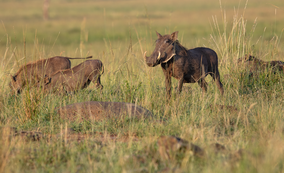Where to Find Them in Kenya: Warthogs are widely distributed across Kenya, with two species present: the common warthog (Phacochoerus africanus) and the desert warthog (Phacochoerus aethiopicus). While the common warthog can be found in many national parks and reserves, the desert warthog has a more limited range. You can spot desert warthogs in:
- Laikipia County, central Kenya
- Tsavo East and Tsavo West National Parks
- Meru National Park
- Kenya's north coast
- Maasai Mara National Park
Speed and Agility: Despite their bulky appearance, warthogs are surprisingly fast. When threatened, they can sprint at speeds up to 50 km per hour (31 mph). This makes them one of the fastest medium-sized animals in the African savanna, outpacing many predators in short bursts.
Character and Behavior: Warthogs are known for their distinctive appearance and quirky behaviour. They're named for the large, wart-like protuberances on their faces, which are actually made of bone and cartilage. Males (boars) have two pairs of these "warts," while females (sows) have one pair.
These resilient animals are generally peaceful but can be formidable when threatened. They're known for their unique defensive strategy of backing into burrows, using their sharp tusks to fend off predators.
Living Style: Warthogs are adaptable and resourceful in their living habits:
Habitat: They prefer open grasslands and savannas but can adapt to various environments.
Burrows: Rather than digging their own, warthogs often inhabit abandoned burrows of other animals like aardvarks or porcupines. These serve as sleeping quarters, nurseries, and safe havens.
Feeding: Warthogs have a unique "kneeling" posture when feeding, thanks to specially adapted protective pads on their wrists. This allows them to graze more easily despite their short necks and long legs.
Diet: Primarily grazers, warthogs mainly eat grass. During dry seasons, they dig for roots and bulbs. Being omnivorous, they may occasionally scavenge meat if available.
Reproduction: Sows typically have litters of two to four piglets. However, the mortality rate is high due to numerous predators.
Warthogs play a crucial role in their ecosystems, contributing to soil aeration through their rooting behaviour and serving as prey for larger predators. Their resilience, unique adaptations, and quirky character make them a fascinating species to observe in Kenya's diverse wildlife landscapes.



